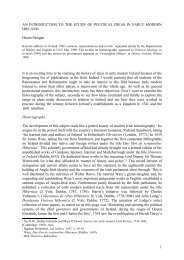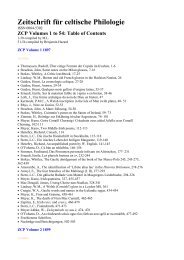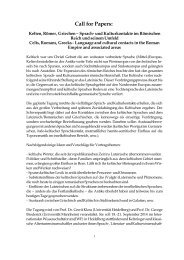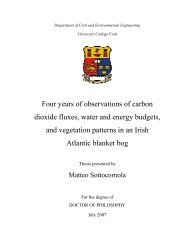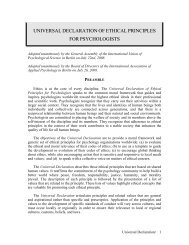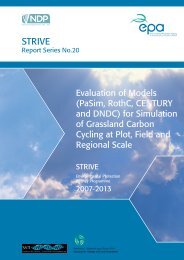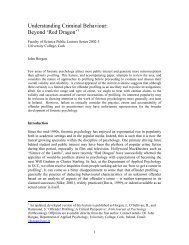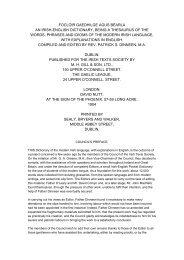wind energy strategies for eastern european countries in - University ...
wind energy strategies for eastern european countries in - University ...
wind energy strategies for eastern european countries in - University ...
You also want an ePaper? Increase the reach of your titles
YUMPU automatically turns print PDFs into web optimized ePapers that Google loves.
Proceed<strong>in</strong>gs of the 2002 Global W<strong>in</strong>d Energy Conference, April 2 – 5, 2002, Paris.<br />
WIND ENERGY STRATEGIES FOR CENTRAL AND EASTERN EUROPEAN COUNTRIES<br />
IN A EUROPEAN UNION CONTEXT<br />
S. N. Udd<strong>in</strong>, B. P. Ó Gallachóir & E. J. McKeogh<br />
Susta<strong>in</strong>able Energy Research Group, Department of Civil & Environmental Eng<strong>in</strong>eer<strong>in</strong>g, <strong>University</strong> College Cork, Ireland<br />
ABSTRACT: The <strong>in</strong>creased use of renewable sources to meet grow<strong>in</strong>g <strong>energy</strong> requirements is widely recognised as essential<br />
<strong>in</strong> the move towards susta<strong>in</strong>able <strong>energy</strong> development. Most developed <strong>countries</strong> <strong>in</strong> the world have already set m<strong>in</strong>imum<br />
targets renewable sources with<strong>in</strong> the total <strong>energy</strong> mix. These targets are <strong>in</strong> many cases quite ambitious and require certa<strong>in</strong><br />
policies and support mechanisms to ensure delivery. The European Commission has set a target of doubl<strong>in</strong>g the share of<br />
renewable <strong>energy</strong> <strong>in</strong> <strong>energy</strong> consumption from around 6 percent <strong>in</strong> 1997 to 12 percent <strong>in</strong> the year of 2010. Several<br />
develop<strong>in</strong>g <strong>countries</strong> <strong>in</strong> the world have also given clear <strong>in</strong>dications of their <strong>in</strong>tention to strengthen the contribution of<br />
renewable sources of <strong>energy</strong>. In the current context of concerns regard<strong>in</strong>g climate change, polices and measures <strong>for</strong><br />
greenhouse gas abatement are be<strong>in</strong>g developed and ref<strong>in</strong>ed <strong>in</strong> many Central and Eastern European <strong>countries</strong> and renewable<br />
sources of <strong>energy</strong> can play a significant role <strong>in</strong> these. Among the different renewable sources of <strong>energy</strong> options, <strong>w<strong>in</strong>d</strong> <strong>energy</strong><br />
is the most promis<strong>in</strong>g one <strong>in</strong> the short term due to the cost competitiveness, size of the resource and recent technological<br />
developments. This paper exam<strong>in</strong>es the <strong>w<strong>in</strong>d</strong> <strong>energy</strong> <strong>strategies</strong> <strong>in</strong> EU Member States and analyses best practice <strong>in</strong> Member<br />
States, based on their relevance to the Central and Eastern European <strong>countries</strong>.<br />
1. Introduction<br />
Energy is a key factor <strong>for</strong> social development and<br />
economic growth. It provides basic needs and services to<br />
all sectors of human activities. But the production and<br />
utilization of <strong>energy</strong> causes environmental degradation at<br />
all levels – local, regional, and global. The basic<br />
elements of susta<strong>in</strong>able <strong>energy</strong> strategy are the most<br />
efficient use of <strong>energy</strong> to create the necessary domestic,<br />
commercial, and <strong>in</strong>dustrial <strong>energy</strong> services; generation of<br />
primary <strong>energy</strong> from renewable <strong>energy</strong> sources; and the<br />
security of supply. Renewable sources of <strong>energy</strong> are<br />
<strong>in</strong>digenous, and can there<strong>for</strong>e contribute to reduc<strong>in</strong>g<br />
dependency on <strong>energy</strong> imports and <strong>in</strong>crease the security<br />
of supply. Also deployment of renewable sources of<br />
<strong>energy</strong> can be a key feature of economic and regional<br />
development with the aim of achiev<strong>in</strong>g greater social and<br />
economic cohesion with<strong>in</strong> the community and at regional<br />
levels and its potential to contribution towards a<br />
susta<strong>in</strong>able development objective. Among different<br />
advantages of us<strong>in</strong>g renewable sources of <strong>energy</strong> the<br />
negative environmental impacts is the most important<br />
one and it can also play an important role <strong>in</strong> <strong>in</strong>tegrat<strong>in</strong>g<br />
the environmental concern <strong>in</strong>to <strong>energy</strong> policy.<br />
2. EU Concerns, Policy and Targets on Renewable<br />
Energy<br />
Europe’s future depends on a secure, af<strong>for</strong>dable and<br />
ecologically susta<strong>in</strong>able <strong>energy</strong> supply. The EU’s<br />
dependence on <strong>energy</strong> imports is already 50 percent and<br />
is expected to rise over the com<strong>in</strong>g years if no action is<br />
taken, reach<strong>in</strong>g 70 percent by 2020 [8]. Renewable<br />
sources of <strong>energy</strong> as <strong>in</strong>digenous sources of <strong>energy</strong> will<br />
have an important role to play <strong>in</strong> reduc<strong>in</strong>g the level of<br />
<strong>energy</strong> imports with positive implications <strong>for</strong> balance of<br />
trade and security of supply. The potential <strong>for</strong> the<br />
exploitation of renewable sources of <strong>energy</strong> is underused<br />
<strong>in</strong> most of the EU member states.<br />
The <strong>energy</strong> policy objectives of the EU were stated <strong>in</strong> the<br />
1995 White Paper ‘An Energy Policy <strong>for</strong> the European<br />
Union’ and were based on the three key <strong>energy</strong> policy<br />
objectives of competitiveness, security of supply and<br />
environmental protection. European Commission 1996<br />
Green Paper on Renewable Energy outl<strong>in</strong>ed other policy<br />
goals to which <strong>in</strong>creased use of renewable <strong>energy</strong><br />
sources can help. These <strong>in</strong>clude regional development,<br />
<strong>in</strong>creased employment, social and economic cohesion,<br />
<strong>in</strong>creased competitiveness, as well as protection of the<br />
environment and security of <strong>energy</strong> supply through the<br />
diversification of <strong>energy</strong> sources. The basic features to<br />
promote renewable <strong>energy</strong> <strong>in</strong> EU <strong>in</strong>clude <strong>energy</strong> security<br />
concerns that emerged <strong>in</strong> the 1970s and encouraged<br />
development of <strong>in</strong>digenous sources, environmental<br />
concerns that arose <strong>in</strong> 1980s (acid ra<strong>in</strong>) and 1990s<br />
(climate change) are now also major motivations <strong>for</strong><br />
renewable <strong>energy</strong> promotion. Economic priorities such as<br />
regional and agricultural development and the export<br />
potential of renewable <strong>energy</strong> technology <strong>in</strong> emerg<strong>in</strong>g<br />
markets are also often cited to support promotion of<br />
renewable <strong>energy</strong>.<br />
Renewable sources of <strong>energy</strong> is <strong>in</strong>creas<strong>in</strong>gly becom<strong>in</strong>g a<br />
vital component <strong>in</strong> total <strong>energy</strong> mix of the 21 st century,<br />
and its successful penetration <strong>in</strong> the market is already<br />
underway <strong>in</strong> many EU member states. Currently,<br />
different renewable sources of <strong>energy</strong> are unevenly and<br />
<strong>in</strong>sufficiently exploited <strong>in</strong> the EU member states. EU<br />
member states differ considerably <strong>in</strong> terms of the<br />
contribution made by renewable <strong>energy</strong> to their <strong>energy</strong><br />
mix. Although many of them are abundantly available,<br />
the real economic potential is considerable. The<br />
European Commission has developed programmes and<br />
legislation to encourage the penetration of renewable<br />
<strong>energy</strong> sources <strong>in</strong> the EU, and <strong>in</strong>crease trade <strong>in</strong> products,<br />
equipment and services with<strong>in</strong> and outside the EU.<br />
In fact, among various renewable sources of <strong>energy</strong>,<br />
<strong>w<strong>in</strong>d</strong> <strong>energy</strong> <strong>in</strong> particular has achieved maturity <strong>in</strong> the<br />
world <strong>energy</strong> market. Among the different <strong>w<strong>in</strong>d</strong> <strong>energy</strong><br />
drivers, environmentally-driven <strong>in</strong> developed <strong>countries</strong><br />
and <strong>energy</strong>-driven <strong>in</strong> develop<strong>in</strong>g <strong>countries</strong> are the<br />
significant ones. Technical maturity of <strong>w<strong>in</strong>d</strong> <strong>energy</strong> has<br />
allowed a number of developed and develop<strong>in</strong>g <strong>countries</strong><br />
to actively exploit this environmentally friendly <strong>energy</strong><br />
source. In addition, a number of proven support<br />
mechanisms namely, feed-<strong>in</strong> tariffs (REFITS), renewable<br />
portfolio standards (with green certificates) and bidd<strong>in</strong>g<br />
Page 1
Proceed<strong>in</strong>gs of the 2002 Global W<strong>in</strong>d Energy Conference, April 2 – 5, 2002, Paris.<br />
processes have substantial importance <strong>for</strong> <strong>w<strong>in</strong>d</strong> <strong>energy</strong><br />
deployment <strong>in</strong> different EU member states depend<strong>in</strong>g on<br />
the local condition. Indeed, the size of the commercial<br />
turb<strong>in</strong>es has <strong>in</strong>creased cont<strong>in</strong>uously from 20-100 kW, to<br />
the present size of 1500 kW and the reliability and<br />
technical availability has <strong>in</strong>creased up to 98-99 percent<br />
<strong>for</strong> on-shore <strong>w<strong>in</strong>d</strong> turb<strong>in</strong>es.<br />
EU targets <strong>for</strong> renewable <strong>energy</strong> will be achieved<br />
through actions at national, regional, and <strong>in</strong>creas<strong>in</strong>gly<br />
local levels. EU legislation has played a significant role<br />
on member states domestic <strong>energy</strong> policies. At the EU<br />
level, the European Commission 1997 White Paper on<br />
renewable <strong>energy</strong> sources set out the objectives of<br />
<strong>in</strong>creas<strong>in</strong>g the share of renewable sources of <strong>energy</strong> to<br />
12% of gross <strong>in</strong>land <strong>energy</strong> consumption by 2010 [16].<br />
As a follow-up to the 1997 White Paper, <strong>in</strong> 1999<br />
European Commission launched the Campaign <strong>for</strong> Take-<br />
Off. The three key renewable <strong>energy</strong> sectors to be<br />
prompted dur<strong>in</strong>g the period 1999-2003 are solar <strong>energy</strong><br />
(photovoltaic and solar thermal), <strong>w<strong>in</strong>d</strong> <strong>energy</strong> and<br />
biomass (comb<strong>in</strong>ed heat and power biomass <strong>in</strong>stallation,<br />
dwell<strong>in</strong>gs heated by biomass, biogas <strong>in</strong>stallation and<br />
biofuels) [9]. These correspond to those technologies and<br />
market sectors where rapid uptake of renewable <strong>energy</strong><br />
use is more likely to occur over this short time <strong>in</strong>terval.<br />
In 2000, the European W<strong>in</strong>d Energy Association<br />
(EWEA) <strong>in</strong>creased its target <strong>for</strong> <strong>in</strong>stalled <strong>w<strong>in</strong>d</strong> power<br />
capacity <strong>in</strong> EU from 40 GW to 60 GW by the year 2010<br />
[21]. The long-term goal of EU is a s<strong>in</strong>gle electricity<br />
market. The European parliament and the council passed<br />
the Directive 2001/77/EC on September 2001 on the<br />
‘Promotion of Electricity Produced from Renewable<br />
Energy Sources <strong>in</strong> the Internal Electricity Market’. This<br />
directive targets 22.1% share of electricity produced<br />
from renewable sources of <strong>energy</strong> <strong>in</strong> total community<br />
electricity consumption by 2010. The Directive specifies<br />
<strong>in</strong>dicative national targets to meet the 22.1%. If<br />
renewable <strong>energy</strong> target are not met, provision <strong>for</strong><br />
mandatory targets and proposals <strong>for</strong> a community<br />
framework. This directive is an important step <strong>for</strong> the<br />
Country<br />
Table 1: EU member states <strong>w<strong>in</strong>d</strong> <strong>energy</strong> <strong>in</strong>stalled capacity, support mechanisms, and national targets<br />
Installed<br />
Capacity MW<br />
end 2001<br />
Support Mechanisms<br />
EU RE Directive<br />
Targets by 2010*<br />
National targets<br />
Germany 8100 Feed-<strong>in</strong> tariffs 10.3% 10-12% renewable <strong>energy</strong> by<br />
2010 without large hydro<br />
Spa<strong>in</strong> 3175 Feed-<strong>in</strong> tariffs 17.5% 12% of power from <strong>w<strong>in</strong>d</strong><br />
<strong>energy</strong> by 2010<br />
Denmark 2417 Feed-<strong>in</strong> tariffs;<br />
Green Certificate (planned)<br />
Italy 560 Feed-<strong>in</strong> tariffs;<br />
Green Certificate (planned)<br />
Netherlands 483 Voluntary Green Certificate<br />
Markets (plus tax rebate)<br />
UK 477 Renewable Obligation<br />
(With tradable certificates)<br />
29% 20% renewable electricity by<br />
2005 and 79% by 2030<br />
14.9% 1000 MW <strong>w<strong>in</strong>d</strong> <strong>energy</strong> by<br />
2006, doubl<strong>in</strong>g share of<br />
renewable electricity by<br />
2010 without large hydro<br />
12% 17% renewable electricity by<br />
2020<br />
10% 5% renewable electricity by<br />
2003, 10% by 2010 than<br />
ma<strong>in</strong>ta<strong>in</strong>ed through to 2025<br />
(with hydro)<br />
Greece 273 Subsidies; Feed-<strong>in</strong> tariffs 14.5% No national targets<br />
Sweden 264 Subsidies; Feed-<strong>in</strong> tariffs 15.7% Increase renewable<br />
electricity with 1.5 TWh<br />
until 2002 (6.8% without<br />
large hydro)<br />
Ireland 132 Competitive bidd<strong>in</strong>g scheme 11.7% 500 MW electricity from<br />
renewable <strong>energy</strong> ma<strong>in</strong>ly<br />
from <strong>w<strong>in</strong>d</strong> <strong>in</strong> 2000-2005<br />
Portugal 127 Subsidies; Feed-<strong>in</strong> tariffs 21.5% No specific targets<br />
France 87 Feed-<strong>in</strong> tariffs (12<br />
MW)<br />
Austria 86 Feed-<strong>in</strong> tariffs; Green<br />
Certificates (small hydro)<br />
F<strong>in</strong>land 39 Subsidies; Tax subsidies; R&D<br />
grants<br />
8.9% New climate action plan<br />
aims <strong>for</strong> 3 GW <strong>w<strong>in</strong>d</strong> <strong>energy</strong><br />
by 2010<br />
21.1% 5% exclud<strong>in</strong>g hydro and<br />
waste by 2005<br />
21.7% Renewable electricity of 8.35<br />
TWh by 2010 of which 1.1<br />
TWh from <strong>w<strong>in</strong>d</strong><br />
Belgium 18 Feed-<strong>in</strong> tariffs; Bidd<strong>in</strong>g system 5.8% Renewable electricity 0.96%<br />
<strong>in</strong> 2001, 3% <strong>in</strong> 2004, and 5%<br />
<strong>in</strong> 2010<br />
Luxembourg 10 Subsidies; Feed-<strong>in</strong> tariffs 5.7% Renewable electricity 5% <strong>in</strong><br />
2010<br />
* (Contribution to electricity exclud<strong>in</strong>g large hydro)Sources: [6], [23]<br />
Page 2
Proceed<strong>in</strong>gs of the 2002 Global W<strong>in</strong>d Energy Conference, April 2 – 5, 2002, Paris.<br />
European <strong>w<strong>in</strong>d</strong> <strong>energy</strong> sector, and <strong>for</strong> other renewable<br />
<strong>energy</strong> sectors as well <strong>in</strong> mak<strong>in</strong>g member states take the<br />
additional policy measures and targets necessary to meet<br />
the 1997 White Paper target.<br />
3. EU MEMBER STATES & WIND ENERGY<br />
There is no unique and policy or support measure <strong>in</strong> the<br />
EU. Most Member States have developed a series of<br />
policy measures and support mechanisms to promote<br />
renewable <strong>energy</strong> utilization with the stated aim of<br />
meet<strong>in</strong>g different multiple objectives. The major and<br />
common drivers <strong>for</strong> national renewable sources of <strong>energy</strong><br />
are oriented to environmental objectives and Kyoto<br />
targets. However, <strong>in</strong>dustrial and economic development,<br />
and employment creation objectives are also very much<br />
beh<strong>in</strong>d the measures commitments <strong>in</strong> a number of EU<br />
member states. To foster the greater utilization of<br />
renewable sources of <strong>energy</strong>, <strong>in</strong>vestment and operat<strong>in</strong>g<br />
supports are the two important market <strong>in</strong>tervention<br />
measures. Investment aids usually the <strong>for</strong>m of capital<br />
grants to reduce the capital costs <strong>for</strong> <strong>in</strong>vestors and<br />
appropriate <strong>for</strong> the early <strong>in</strong>troduction of markets <strong>in</strong> one<br />
hand. Operat<strong>in</strong>g aid provides a direct <strong>in</strong>centive to<br />
maximize the power output from a project on the other<br />
hand. Price and quantity are the two market variables<br />
where government <strong>in</strong>tervention to provide operat<strong>in</strong>g<br />
support can act actively. Table 1 gives the details of<br />
support mechanisms <strong>in</strong> EU member states with <strong>in</strong>stalled<br />
capacity of <strong>w<strong>in</strong>d</strong> <strong>energy</strong> by the end of 2001 and their<br />
national targets and EU Renewable Energy Directive<br />
targets (exclud<strong>in</strong>g large hydro power).<br />
4. CENTRAL AND EASTERN EUROPEAN<br />
COUNTRIES CONTEXT<br />
Most of the Central and Eastern European Countries are<br />
currently undergo<strong>in</strong>g major political, economic, and<br />
structural re<strong>for</strong>ms. EU member governments signed the<br />
‘Treaty of Nice’ <strong>in</strong> 2001 and it has changed the way of<br />
operation of EU <strong>in</strong>stitutions <strong>in</strong> order to make possible<br />
admission of new member states <strong>in</strong> future [19]. Czech<br />
Republic, Hungary, and Poland are among the other<br />
Central and Eastern European <strong>countries</strong> expected to jo<strong>in</strong><br />
the EU <strong>in</strong> future. Each of these <strong>countries</strong> has a unique<br />
socio-economic context, caus<strong>in</strong>g variation <strong>in</strong> the<br />
transition process across all <strong>countries</strong> <strong>in</strong> the region.<br />
Former state-owned firms are be<strong>in</strong>g <strong>in</strong>ternally<br />
restructured, shift<strong>in</strong>g from public ownership with state<br />
control to various types of private ownership. Climate<br />
change policies are currently be<strong>in</strong>g developed and<br />
ref<strong>in</strong>ed <strong>in</strong> these <strong>countries</strong> with a clear role <strong>for</strong> <strong>w<strong>in</strong>d</strong><br />
<strong>energy</strong>.<br />
4.1. Czech Republic<br />
Czech Republic is expect<strong>in</strong>g full membership of EU by<br />
2003-2005 [11]. The <strong>energy</strong> policy of Czech Republic<br />
focuses to harmonise EU <strong>energy</strong> policy objectives. In<br />
January 2000, the Czech Government adopted the new<br />
<strong>energy</strong> policy document and it <strong>in</strong>cludes environmental<br />
protection; adherence to the pr<strong>in</strong>ciples of susta<strong>in</strong>able<br />
development; assurance of <strong>energy</strong> supply security; and<br />
support <strong>for</strong> competitiveness of the <strong>energy</strong>-economy [20].<br />
The new Energy Act and new Energy Economy Act are<br />
also modelled on EU legislation. In the current policy<br />
objectives, the government’s goal target <strong>for</strong> renewables<br />
is a 5-6% share of primary <strong>energy</strong> by 2010 and 8-10%by<br />
2020 if appropriate policy measures are taken to tackle<br />
market barriers [13]. S<strong>in</strong>ce 1991, a specific program<br />
aimed at develop<strong>in</strong>g renewable <strong>energy</strong> production has<br />
been implemented and it <strong>in</strong>clude certa<strong>in</strong> <strong>in</strong>centives <strong>for</strong><br />
<strong>w<strong>in</strong>d</strong> <strong>energy</strong> as well such low VAT rate (5%<strong>in</strong>stead of<br />
22%) <strong>for</strong> small facilities of 0.075 MW <strong>w<strong>in</strong>d</strong> <strong>energy</strong><br />
<strong>in</strong>stallation; direct <strong>in</strong>vestment subsidies (17% of total<br />
<strong>in</strong>vestment costs) <strong>for</strong> 7 MW <strong>w<strong>in</strong>d</strong> <strong>energy</strong>; and reduced<br />
import duties on renewable <strong>energy</strong> equipment [13]. S<strong>in</strong>ce<br />
2000, the country has participated <strong>in</strong> the EU ALTENER,<br />
program. The overall potential of <strong>w<strong>in</strong>d</strong> <strong>energy</strong> is small,<br />
only a small market share has ga<strong>in</strong>ed. By the end of<br />
2001, total <strong>w<strong>in</strong>d</strong> <strong>energy</strong> <strong>in</strong>stalled capacity was 12 MW<br />
[23].<br />
4.2. Hungary<br />
Hungary is expect<strong>in</strong>g accession to the EU by 2004, and<br />
adoption of EU <strong>energy</strong> directives is there<strong>for</strong>e great<br />
importance [2]. The Government is committed to<br />
liberaliz<strong>in</strong>g the electricity and natural gas markets. The<br />
1999 Energy Plan <strong>in</strong>dicates a movement toward cleaner<br />
technologies; <strong>in</strong>clud<strong>in</strong>g emissions controls <strong>for</strong> coal-fired<br />
generation; and eventual replacement of some coal-fired<br />
power plants with gas turb<strong>in</strong>es. The basic features of<br />
<strong>energy</strong> policy are to develop diverse <strong>energy</strong> supplies and<br />
elim<strong>in</strong>ate dependency on imports; improve<br />
environmental protection; to <strong>in</strong>crease <strong>energy</strong> efficiency<br />
with better management of electricity consumption; and<br />
to attract <strong>for</strong>eign capital <strong>for</strong> <strong>in</strong>vestment <strong>in</strong> capital<strong>in</strong>tensive<br />
<strong>energy</strong> projects [2]. At present renewable<br />
sources of <strong>energy</strong> represent only 2% of the total <strong>energy</strong><br />
market. The National Energy Action Plan of 1999<br />
<strong>in</strong>dicates the <strong>in</strong>crease use of renewable sources of <strong>energy</strong><br />
is a priority area and <strong>in</strong>troduces a number of actions to<br />
assist its promotion [14]. Hungary’s first <strong>w<strong>in</strong>d</strong> power<br />
plant is a small facility and prov<strong>in</strong>g electricity <strong>for</strong> about<br />
750 residents [2].<br />
4.3. Poland<br />
Poland is currently undergo<strong>in</strong>g re<strong>for</strong>ms necessary to meet<br />
the EU membership criteria. The <strong>energy</strong> sector will be<br />
open <strong>for</strong> competition by 2004 [12]. The key objectives of<br />
1997 New Energy Act are security of <strong>energy</strong> supplies,<br />
requir<strong>in</strong>g diversification of sources, <strong>in</strong>creased<br />
competitiveness of Polish <strong>energy</strong> sources <strong>in</strong> domestic and<br />
<strong>in</strong>ternational markets, environmental protection,<br />
improv<strong>in</strong>g <strong>energy</strong> efficiency, and reduc<strong>in</strong>g <strong>energy</strong> related<br />
emissions [12]. The new Energy Law gives the<br />
opportunity to foster <strong>energy</strong> sav<strong>in</strong>g <strong>in</strong>novative methods<br />
and the <strong>in</strong>vestments <strong>in</strong> clean technologies are supported.<br />
Renewable <strong>energy</strong> as one of the idea <strong>for</strong> clean <strong>energy</strong> can<br />
be recognised as one options to achieve environmental<br />
targets. In addition, the Energy Law also conta<strong>in</strong>s several<br />
provisions, which may assist the present and/or future<br />
development of renewable <strong>energy</strong>. The regulation of the<br />
M<strong>in</strong>istry of Economy on obligation of buy<strong>in</strong>g electricity<br />
and heat from non-conventional sources of <strong>energy</strong>,<br />
<strong>in</strong>clud<strong>in</strong>g renewable sources of <strong>energy</strong> became effective<br />
s<strong>in</strong>ce 1999 [5]. The Parliament of the republic of Poland<br />
adopted the resolution concern<strong>in</strong>g the development and<br />
utilization of <strong>energy</strong> from renewable <strong>energy</strong> sources on<br />
July 8, 1999 and imposed on the government the<br />
Page 3
Proceed<strong>in</strong>gs of the 2002 Global W<strong>in</strong>d Energy Conference, April 2 – 5, 2002, Paris.<br />
development strategy <strong>for</strong> the development of renewable<br />
<strong>energy</strong> <strong>in</strong> Poland, together with a program of short,<br />
middle, and long-term activities ensur<strong>in</strong>g suitable<br />
<strong>in</strong>crease of utilization of renewable sources of <strong>energy</strong><br />
[10]. On September 5, 2000, <strong>in</strong> respond to the<br />
Resolution, the government adopted a document<br />
‘Development Strategy <strong>for</strong> Renewable Energy Sector’<br />
prepared <strong>in</strong> compliance with an obligation follow<strong>in</strong>g the<br />
resolution. The Strategy set up the quantitative goals <strong>for</strong><br />
the sector development: 7.5 percent contribution of<br />
renewable sources of <strong>energy</strong> <strong>in</strong> 2010 and 14.5 percent <strong>in</strong><br />
2020. W<strong>in</strong>d power only began to develop <strong>in</strong> Poland at<br />
the beg<strong>in</strong>n<strong>in</strong>g of 1990s. In 1999, <strong>energy</strong> production from<br />
<strong>w<strong>in</strong>d</strong> <strong>energy</strong> was only 0.01 percent <strong>in</strong> Poland [10]. Only<br />
14 <strong>w<strong>in</strong>d</strong> firms with the total power over 3.5 MW had<br />
been connected to the grid and placed <strong>in</strong> service. About<br />
50 small <strong>in</strong>dependent <strong>w<strong>in</strong>d</strong> turb<strong>in</strong>es are <strong>in</strong> operation now.<br />
By the end of 2001, total <strong>w<strong>in</strong>d</strong> <strong>energy</strong> <strong>in</strong>stalled capacity<br />
was 16 MW [23].<br />
5. INITIAL RECOMMENDATIONS<br />
Major factors <strong>in</strong>fluenc<strong>in</strong>g the renewable <strong>energy</strong><br />
deployment are political, legislative, f<strong>in</strong>ancial, fiscal,<br />
technological development, and <strong>in</strong><strong>for</strong>mation<br />
dissem<strong>in</strong>ation. Most of the EU member states are one<br />
step ahead <strong>in</strong> design<strong>in</strong>g and implement<strong>in</strong>g the policy and<br />
appropriate measures <strong>for</strong> the development and greater<br />
utilization of renewable sources of <strong>energy</strong>. Among them,<br />
several support mechanism and schemes have been<br />
exam<strong>in</strong>ed so far <strong>for</strong> different renewable sources of<br />
<strong>energy</strong>. These different national schemes have <strong>in</strong>dividual<br />
characteristics depend<strong>in</strong>g on the type of sources covered<br />
(renewable and non-renewable as wastes), length of<br />
validity, and different national contexts. Among the<br />
several support mechanisms, experience shows that the<br />
greatest development <strong>in</strong> Europe occurs <strong>in</strong> the <strong>countries</strong><br />
that operate feed-<strong>in</strong> tariffs systems. The three <strong>countries</strong> <strong>in</strong><br />
EU Germany, Spa<strong>in</strong> and Denmark that account <strong>for</strong> the<br />
great majority of <strong>w<strong>in</strong>d</strong> <strong>energy</strong> development applied this<br />
system. So far, <strong>countries</strong> with great <strong>w<strong>in</strong>d</strong> <strong>energy</strong><br />
potential such as UK have not yet achieved their targets<br />
<strong>for</strong> renewable electricity by implement<strong>in</strong>g auction-based<br />
schemes. Green certificates trad<strong>in</strong>g schemes, <strong>in</strong> various<br />
<strong>for</strong>ms are be<strong>in</strong>g <strong>in</strong>troduced <strong>in</strong> a number of EU member<br />
states but are still untested <strong>in</strong> Europe.<br />
The Central and Easter European <strong>countries</strong> are at the<br />
<strong>in</strong>itial stage of address<strong>in</strong>g the greater utilization of<br />
renewable sources of <strong>energy</strong> and to comply with EU<br />
targets. Initially, policy objectives towards the greater<br />
penetration of renewable sources of <strong>energy</strong>, specifically<br />
<strong>for</strong> <strong>w<strong>in</strong>d</strong> <strong>energy</strong> would be appropriate <strong>for</strong> Central and<br />
Eastern European <strong>countries</strong>. Regard<strong>in</strong>g the support<br />
mechanism, the feed-<strong>in</strong> tariffs recommended <strong>for</strong> Central<br />
and Eastern European <strong>countries</strong> context and shift towards<br />
mechanisms more compatible with liberalised electricity<br />
markets, which closely progress with tradable green<br />
certificates.<br />
6. REFERENCES<br />
[1] An Energy Overview of the Czech Republic<br />
http://www.fe.doe.gov/<strong>in</strong>ternational/czekover.html<br />
(10/12/2001)<br />
[2] An Energy Overview of the Republic of Hungary<br />
http://www.fe.doe.gov/<strong>in</strong>ternational/hungover.html<br />
(10/12/2001)<br />
[3] An Energy Overview of the Republic of Poland,<br />
http://www.fe.doe.gov/<strong>in</strong>ternational/plndover.html<br />
(10/12/2001)<br />
[4] BTM Consult, A Tower<strong>in</strong>g Per<strong>for</strong>mance - Latest<br />
BTM Report on the W<strong>in</strong>d Industry, Renewable Energy<br />
World, Review Issue, pp. 69-87 (2001-2002)<br />
[5] D. Chwieduk, New Opportunities <strong>for</strong> Renewable<br />
Energy <strong>in</strong> Poland (undated)<br />
[6] E. Metreau, Country Report 2000, Green Electricity<br />
and the Electricity Market Liberalization <strong>in</strong> EU member<br />
states, Green Energy Company and SERG/UCC<br />
(unpublished, 2001)<br />
[7] Eastern Europe,<br />
http://www.eia.doe.gov/emeu/pgem/ch4c.html<br />
(12/12/2001)<br />
[8] European Commission, Energy <strong>for</strong> the Future:<br />
Renewable Sources of Energy, White Paper <strong>for</strong> a<br />
Community Strategy and Action Plan, COM (97) 599<br />
f<strong>in</strong>al (26/11/1997)<br />
[9] European Environment Agency, Renewable Energies:<br />
Success Stories, Copenhagen, (2001)<br />
[10] G. Wisniewski, Development Strategy of<br />
Renewable Energy Sector, 7 th Polish-Danish Workshop<br />
on Biomass <strong>for</strong> Energy, December 7-10, 2000,<br />
Starbien<strong>in</strong>o, Poland<br />
[11] http://www.eia.doe.gov/emeu/cabs/czech2.html<br />
(10/12/2001)<br />
[12] http://www.eia.doe.gov/emeu/cabs/poland2.html<br />
(10/12/2001)<br />
[13] International Energy Agency, Energy Policies of<br />
IEA Countries: Czech Republic 2001 Review, Paris,<br />
(2001)<br />
[14] K. Pankasz, Successful Example <strong>for</strong> Promot<strong>in</strong>g<br />
Renewable at Local Level <strong>in</strong> Hungary, (undated)<br />
[15] M. Voogt and et al., Development of Long-Term<br />
Energy Scenarios <strong>for</strong> the Czech Republic, (undated)<br />
[16] Official Journal of the European Commission,<br />
Directive 2001/77/EC of the European Parliament and of<br />
the Council, on the Promotion of Electricity Produced<br />
from Renewable Energy Sources <strong>in</strong> the Internal<br />
Electricity Market, (September 27, 2001)<br />
[17] Poland: Environmental Issues,<br />
http://www.eia.doe.gov/emeu/cabs/polenv.html<br />
(10/12/2001)<br />
[18] R. Redl<strong>in</strong>ger, Review of International Renewable<br />
Energy Polices, UNCCEE/RISO, Denmark (1998)<br />
[19] Regional Indicators: European Union (EU),<br />
http://www.eia.doe.gov/emeu/cabs/euro.html<br />
(12/12/2001)<br />
[20] SEVn, The Energy Efficiency Centre, Energy and<br />
Economic Bullet<strong>in</strong> <strong>for</strong> the Czech Republic, (March 2001)<br />
[21] V. Pollard, W<strong>in</strong>d <strong>in</strong> Europe - Developments <strong>in</strong> the<br />
Policy Frameworks <strong>for</strong> W<strong>in</strong>d Energy, Renewable Energy<br />
World, Review Issue, pp. 89-101 (2001-2002)<br />
[22] W<strong>in</strong>d Directions, Magaz<strong>in</strong>e of the European W<strong>in</strong>d<br />
Energy Association, (July 2001)<br />
[23] W<strong>in</strong>d Power Monthly, page no 50, Volume 18, No.<br />
1, (January 2002)<br />
Page 4



